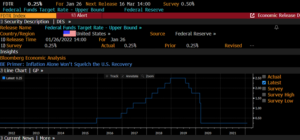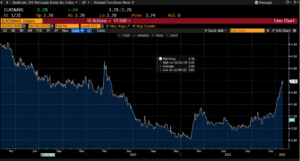It may have been COVID’s one bright spot: the drop in interest rates for home buyers. Between March 2020 and February 2021, rates dropped an average of 1.61% nationwide. And consumers took advantage of the opportunity, grabbing up existing inventory and refinancing at record levels.
But after two years of rock-bottom rates, the Federal Reserve System, known as the Fed, has indicated it plans to increase rates for the first time in three years.
That should matter to you if you’re in the market for a new home.
First, a little background on the Fed. According to Andrew Murray, senior vice president, capital markets for Union Savings Bank, the Fed has two goals: full employment and controlling inflation. With an unemployment rate hovering at about 4%, the U.S. is considered to be at full employment.
Inflation, however, is on the rise.
According to the Bureau of Labor Statistics data, inflation will likely peak at about 7% before getting back to the target inflation rate of 2.5%, which is anticipated by the end of 2023.
How did we get to 7% inflation?
“The historic surge in inflation is pandemic-related,” said Murray. “To keep America going, the Fed cut the federal funds rate to 0.25% and injected a whole bunch of money into the economy. At first, people were afraid to spend. Gradually, pent-up demand for goods and services increased. The economy recovered fairly quickly, but the money kept coming and the rates stayed low. The supply chain couldn’t keep up, prices started to increase and inflation reached a 40-year high.”
To reverse course, the Fed is projecting an increase in the federal funds rate.
“The federal funds rate is not necessarily a mortgage rate, but everything builds off of that rate,” says Murray. “Like all treasury securities, the federal funds rate is risk-free. Mortgage rates are added to that rate, so if the risk-free rates go up, so do the mortgage rates. Everything is connected.”

Federal Funds Target Rate (Source: Bloomberg)
Analysts predict that the Fed will increase the federal funds rate gradually throughout the year, beginning in March. The amount of increase and timing is uncertain, with predications ranging from four to seven increases to a rate of 1.25% to 2%.
For home buyers, that means “until inflation levels off, you’re going to keep seeing mortgage rates rise,” says Murray. “The lowest rates you’ll see this year, you’re probably seeing right now.”
But that doesn’t mean home buyers should act impulsively. Murray says while rates will rise, the increases will not be huge. In the early 2000s mortgage rates hit 8% and that was good compared to rates dating back to the 1970s. Today, rates remain under 4%.

Bankrate 30 Year Mortgage Rates (Source: Bloomberg)
Union Savings Bank (USB) offers a variety of loan products that work with your housing needs and your finances.
If you’re looking for a forever home, locking in at our lowest fixed rate may be the way to go. But if you’re more in search of a starter home to live in for a few years, you’ll want to consider a USB ARM product, which offers an adjustable rate that’s lower in the early years of the loan.
Don’t let news about inflation and interest rates panic you or cause you to delay your dream of home ownership. Contact a USB loan officer today. Our experienced team can walk you through the process to help you identify the best loan product and determine if the time is right for you to make your move.
